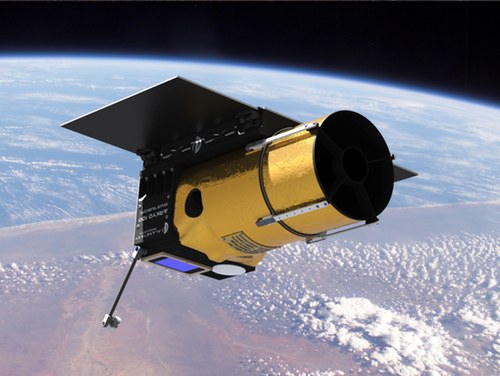
Illustration of a Planetary Resources Arkyd-100 spacecraft in orbit. A company official showed last month a larger version of the larger Arkyd-200 series that could launch as soon as late 2015. (credit: Planetary Resources, Inc.)
The Wall Street Journal yesterday reported what it considered a bit of a scoop: that asteroid mining company Planetary Resources had pivoted on its business plan. “Now, largely without publicity, the team of former National Aeronautics and Space Administration officials that runs Planetary Resources has shifted the company’s focus to a more mundane space resource: water,” the Journal reported in an article headlined “What Happened to That Crazy Asteroid Mining Plan?”. According to the Journal, the company was now focused extracting water from asteroids to use as propellant.
There’s just once problem with that breaking development: it’s not new. Indeed, since the company unveiled its plans a little more than two years ago, the company has emphasized plans to extract water from asteroids for use as propellant. “If we were able to provide that propellant for a price of one-tenth of the effective cost of bringing it from the Earth, that would shave off a large portion of the cost of going into deep space,” company co-founder Eric Anderson told me in an interview just before the company announced its existence in April 2012. So that shift in focus the Journal crowed about was not really a shift at all.
But don’t trust just me. “At an event at the Seattle Museum of Flight, a group that included former National Aeronautics and Space Administration officials unveiled Planetary Resources Inc. and said it is developing a ‘low-cost’ series of spacecraft to prospect and mine ‘near-Earth’ asteroids for water and metals,” the Journal reported about Planetary Resources in April 2012 (emphasis added).
The company also hasn’t abandoned interest in extracting other resources from asteroids. In a presentation during a space panel at the AwesomeCon science fiction convention in Washington, DC, last month, Peter Marquez, vice president of global engagement for Planetary Resources, said the company was also interested in extracting metals, in particular platinum-group metals, from asteroids.
At that panel, Marquez did reveal a different, more technical, shift in the company’s work. He revealed a new design for the company’s Arkyd-200 series of spacecraft that he dubbed “HomerSat,” after cartoon character Homer Simpson and his love of donuts. “It’s a telescope wrapped in fuel tanks,” he said of the design, showing a telescope surrounded by two toroidal propellant tanks. “It looks like two donuts stuck on top of each other.”
Those propellant tanks give the spacecraft, weighing a couple hundred kilograms, as much as 5 kilometers per second of delta-v, making it very maneuverable. “We can scoot around quite a bit, quite often,” Marquez said.
That Arkyd-200 spacecraft could launch as soon as late next year, he said, although the company was still working on launch arrangements. A small prototype satellite is scheduled to be launched later this year from the International Space Station.

Can someone explain to me, how you going to find water on Near Earth Objects?…. when these rocks have been coming in and out around earth’s orbit, baking in the sun on and off for a few hundred degrees for decades and centuries …. Since Most NEO(or the one that we can manipulate)are pretty small and don’r have enough thermal mass, I am guessing all water is going be boiled off long ago.
Won’t be surprised if they “pivot” again, or is that another world for “screwd up”?
@Larry
Surface water may have boiled off, but there is water (or ice) inside asteroids which can be extracted. You can read more about their plans:
http://www.planetaryresources.com/asteroids/composition/
I’ve met several of their staff members, they are quite brilliant and very engaging. I bet if you contacted them (http://www.planetaryresources.com/contact/),they’d be happy to answer your question.
Some NEOs are dormant or extinct comets. Either, they haven’t been around long enough to be ‘baked out’, or their surface crust protects the ice-rich interior. Third possibility is that water is present as phyllosilicates, i.e. bound to the rock, where it is stable up to a few 100 deg. C.
Carbonaceous chondrites may contain as much as 20% water and are relatively common but dark and may be difficult to identify.
Larry, hydrated minerals are seen spectroscopically, on the surfaces of many asteroids.
Check figure 6 in
http://www.lpi.usra.edu/books/AsteroidsIII/pdf/3031.pdf?q=hydrated%C3%AF%C2%BB%C2%BF
Heating will drive off adsorbed water (ie, molecular water that is not chemically bound) but structural water (think hydrated copper sulphate, etc.) remains.
I quote, “…suggests that hydrated minerals can survive not only impact and ejection but millions of years in vacuum, followed by atmospheric entry.”
In-situ hydrated minerals have been seen by spacecraft as well, look at Dawn’s encounter with Vesta.
PR’s idea to forgo the platinum group elements makes perfect sense – volatiles such as water are absolutely the key to cheap transport in the inner solar system.
I love how people will complain about anything just to get a good story that catches people’s attention, even though they don’t really understand what’s going on.